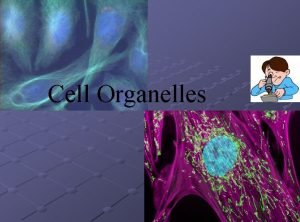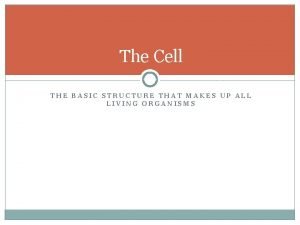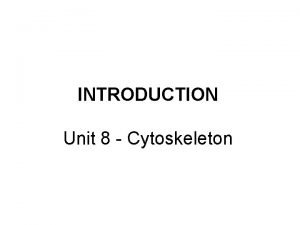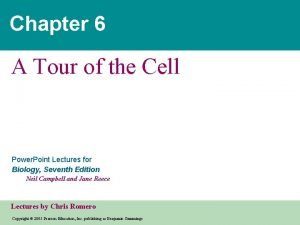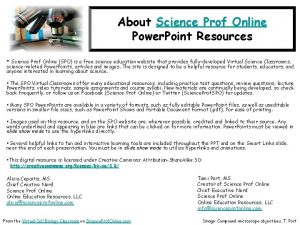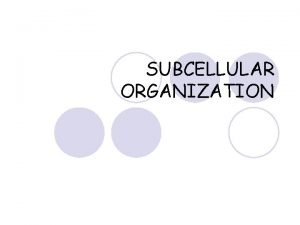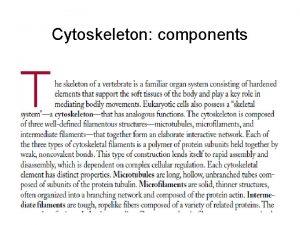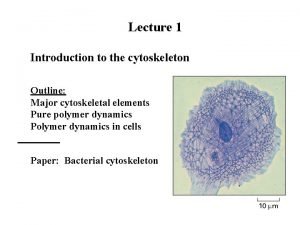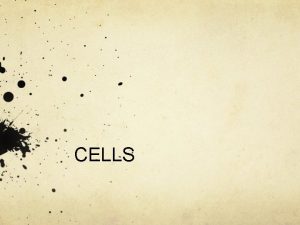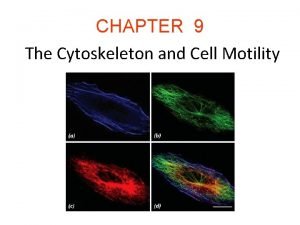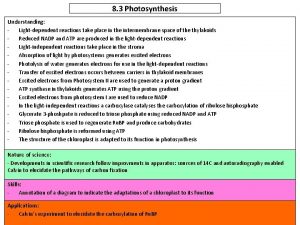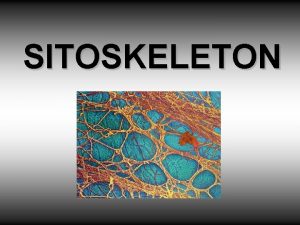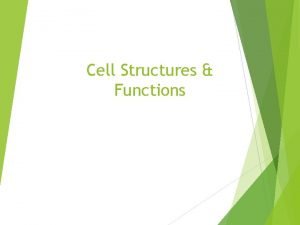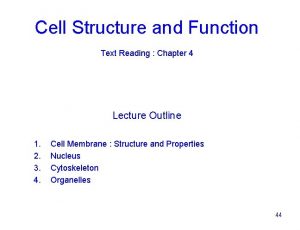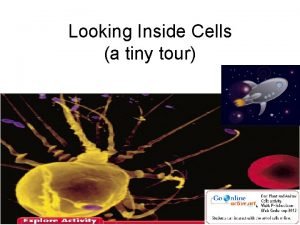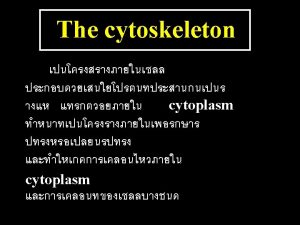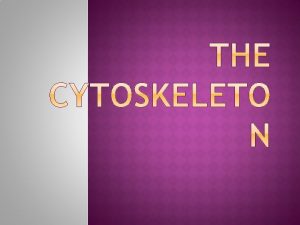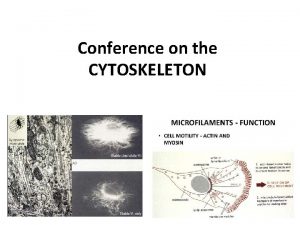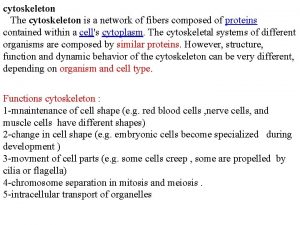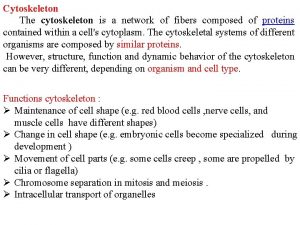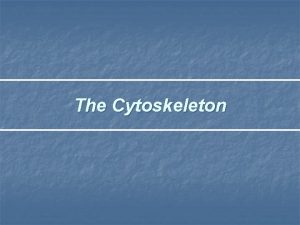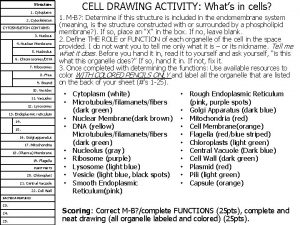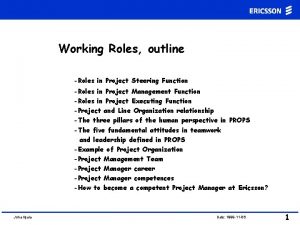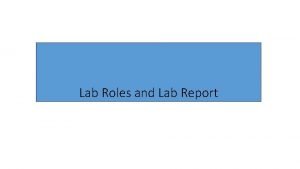10 Cytoskeleton 10 2 Roles of the Cytoskeleton

































- Slides: 33

10 Cytoskeleton

10 2 Roles of the Cytoskeleton The eukaryotic cytoplasm has a set of long, thin fibers called the cytoskeleton, which plays three important roles in cellular structure and function: 1. Maintains cell shape and support. 2. Provides for various types of cell movement. 3. Helps move and organize things within the cell.

10 3 Cytoskeleton distribution

10 4 Roles of the Cytoskeleton: Mechanical strength Structural support Internal organization Movement Microfilaments Intermediate filaments Microtubules

10 5 Intermediate filaments are made up of fibrous proteins that are organized into tough, ropelike assemblages (Coiled coils). They have two major structural functions: 1. They stabilize cell structure. 2. They resist tension. Fibrous subunit

10 6 Intermediate filaments (along with desmosomes) strengthen cells against mechanical stress Nuclear lamina Keratin

10 7 Microtubules are long, hollow cylinders made up of many molecules of the protein tubulin. Consists of two subunits: -tubulin and -tubulin. Microtubules have two roles: 1. They form a rigid internal skeleton. 2. They act as a framework along which motor proteins can move and organize structures in the cell. + End - End Tubulin dimer -Tubulin monomer

10 Microtubules are directional. Often originate from a center close to the nucleus: the Centrosome 8 Microtubules

10 9 Microtubule assembly Microtubules grow and shrink constantly . . Movies17. 4 -microtubule_dynamics. mov

10 10 Centrosome Microtubules radiate from microtubule organizing center (MTOC)(centrosome) and function during cell division Centrosome

10 11 Movement along Microtubules act as a framework along which motor proteins can move and organize structures in the cell.

10 12 Motor proteins • Motor proteins move along microtubules. • Dynein moves vesicles toward the minus end of the microtubule. Kinesin, another motor protein, moves them toward the plus end.

10 13 Kinesin function • Motor proteins move along microtubules. • Motor Proteins Use Energy from ATP to Move Things. • Motor proteins change their shape when energy is released from ATP. . . Movies17. 5 -kinesin. mov

Figure 4. 24 Motor Proteins Use Energy from ATP to Move Things (Part 2)

10 Melanosomes movements in fish pigment cells 15

10 Melanosomes movements in fish pigment cells 16

10 17 Vesicular transport along microtubules . . Moviesves 1. mov

10 18 Generating movement with microtubules • Cilia and flagella, common locomotary appendages of cells, are made of microtubules. • Flagella are typically longer than cilia, and cells that have them usually have only one or two. • Cilia are shorter and usually present in great numbers.

Figure 4. 23 Cilia are Made up of Microtubules (Part 1)

10 20 Generating movement • The microtubules in cilia and flagella are arranged in a 9 + 2 array. • At the base of each flagellum or cilium is a basal body. The nine pairs extend into the basal body.

10 21 Motor proteins • In both cilia and flagella, the microtubules are cross-linked by spokes of the motor protein called dynein. • Dynein changes its shape when energy is released from ATP. Many dynein molecules associate along the length of the microtubule pair. • Dynein moves vesicles toward the minus end of the microtubule. Kinesin, another motor protein, moves them toward the plus end.

Figure 4. 24 Motor Proteins Use Energy from ATP to Move Things (Part 1)

10 23 Motor proteins

10 24 Microfilaments are made up of strands of the protein actin. Major roles: 1. Stabilize cell shape. 2. Promote Cell movement 3. Cytoplasmic streaming Actin monomer

10 25 Actin polymerization depends on ATP and monomer concentration and results in a steady state.

10 26 Actin binding proteins Many proteins bind to actin filaments and modify them

10 27 Microfilaments for Support

10 28 cytoskeleton and cell movement Myosin is a motor protein that moves along Actin filaments Myosin is organized in bundles

10 29 cytoskeleton and cell movement Myosin is a motor protein that moves along Actin filaments Myosin is organized in bundles Actin and Myosin function in muscle contraction

10 30 cytoskeleton and cell movement Actin Filaments polymerize at the growing edge of cells.

10 31 cytoskeleton and cell movement Actin Filaments polymerize at the growing edge of cells. . . MoviesCell_Motility. mov . . MoviesActin_in_Lamellipodia. mov

10 32 Listeria parasites use actin to move . . Movies17. 9 -listeria_parasites. mov

10 33 Video 4. 3 Tradescantia stamen hair cell • Cytoplasmic streaming . . MoviesCyt stream. mpg
 Eukaryotic cell
Eukaryotic cell Cytoskeleton look like
Cytoskeleton look like Intermediate filament tetramer
Intermediate filament tetramer Cytoskeleton
Cytoskeleton Nickname for cytoskeleton
Nickname for cytoskeleton Cytoskeleton
Cytoskeleton Commassie
Commassie Introduction of cytoskeleton
Introduction of cytoskeleton Cytoskeleton prokaryotic or eukaryotic
Cytoskeleton prokaryotic or eukaryotic 3 cytoskeletal elements
3 cytoskeletal elements Cytoskeleton look like
Cytoskeleton look like Mikrotubule
Mikrotubule Centrioles analogy
Centrioles analogy Prokaryotes and eukaryotes
Prokaryotes and eukaryotes Cytoskeleton organelles
Cytoskeleton organelles Cell analogy of a school
Cell analogy of a school Chloroplast function
Chloroplast function Nguyên nhân của sự mỏi cơ sinh 8
Nguyên nhân của sự mỏi cơ sinh 8 độ dài liên kết
độ dài liên kết Trời xanh đây là của chúng ta thể thơ
Trời xanh đây là của chúng ta thể thơ Voi kéo gỗ như thế nào
Voi kéo gỗ như thế nào Thiếu nhi thế giới liên hoan
Thiếu nhi thế giới liên hoan Phối cảnh
Phối cảnh điện thế nghỉ
điện thế nghỉ Một số thể thơ truyền thống
Một số thể thơ truyền thống Thế nào là hệ số cao nhất
Thế nào là hệ số cao nhất Ng-html
Ng-html Sơ đồ cơ thể người
Sơ đồ cơ thể người Số nguyên là gì
Số nguyên là gì đặc điểm cơ thể của người tối cổ
đặc điểm cơ thể của người tối cổ Các châu lục và đại dương trên thế giới
Các châu lục và đại dương trên thế giới Mật thư tọa độ 5x5
Mật thư tọa độ 5x5 Tư thế worm breton
Tư thế worm breton ưu thế lai là gì
ưu thế lai là gì
